Tasmania’s jewel in the crown is undoubtedly the wild brown trout.
It is often said by commentators far wiser than I that Tasmania has the best wild strains of wild brown trout anywhere in the world. While that might sound like a whole lot of angling hyperbole, Tasmania does undoubtedly have the best wild brown trout fishing in Australia.
While Tasmania does have an active and dedicated government department solely for the purpose of managing trout in Tasmania, much of the best fishing and fisheries require absolutely no management at all save for the imposition of closed seasons and bag limits.
Spared the worst of the recent extended drought, Tasmania’s freshwater fisheries have maintained their wild status and haven’t required the massive stocking of domestic trout that Victoria and New South Wales have had to undertake.
The difference in the angling experience between wild trout and domestic trout is incredible. Many of Tasmania’s fisheries have only been stocked by human hand once – up to 150 years ago in some cases. Take for example the wild western lakes region on the central plateau – many of these lakes were invaded by trout a few years after trout were first hatched and released into the Plenty River (a tributary of the Derwent River). They made their way upstream and populated lakes and rivers in the myriad headwaters of the Derwent without any human interference at all.
The difference in the angling challenge therefore between catching a trout raised on pellets in a hatchery to one with 150 years of wild upbringing is massive.
So having established that Tasmania’s wild trout present a magnificent challenge, when then does the angler best experience that challenge. Summer is clearly an amazing time to fish Tasmania, but spring provides some of the best all round fishing of the year, especially in the highland lakes.
While spring in lower altitudes is really September to the beginning of December, we really don’t pass spring until the end of December.
This is one water that, like many, is a Hydro impoundment. However the Pine River was one of those waterways that trout had populated long before anglers turned their attention here. Apart from a few shepherds poling a few trout out, the Pine River didn’t receive much attention until the 1950’s. In the early 1960’s the lake was created to divert water to the east into Lake Echo via Monpeelyata Canal.
This created one of the famous highland waters – awesome tailing trout in spring; massive mayfly hatches in summer.
In spring the high rainfall in the catchment higher up the plateau means than this quite small water can spill over the dam wall quite dramatically. This pushes water into the grassy and tussocky margins and floods out worms and grubs – closely pursued by willing wild brown trout.
This doesn’t happen often – if you can strike it once or twice a season you have done well, and the sight of dozens of trout swirling in the shallows will stay with you forever. Best of all they are suckers for a dry fly!
At lower lagoon levels the tailing brown trout are legendary, and very tough! I know anglers who have caught one fish in three years when chasing tails – but I also know plenty who regularly catch two or three every early morning session.
Presenting to these fish at normal levels means a dry fly and nymph combination, often a small fly such as a 007 nymph or Fiery Brown Beetle hung 100mm under a dry fly such as a Red Tag or similar. If at first you don’t succeed, then try, try again. Catch one of these fish and you join an exclusive band of flyfishers who have ‘done well at the Pine’.
This is perhaps one of the best all round wild brown trout lakes in the world. It has it all, great dry fly fishing, tailing fish, superb lure fishing and the bait fishers do well too. Water quality issues have been a concern in recent seasons with an extensive algae making the normally clears waters an opaque ‘grey’ colour, very similar to Woods Lake.
While this isn’t what we have come to expect from Arthurs, the fishing has really bounced back from the low point of the massive drawdown in 2006-8.
In spring there are many opportunities, especially with record high water levels that will probably continue until late spring.
Flooded margins are perhaps the best opportunity, with many fish moving into the extreme shallows looking for worms and grubs. Other aquatic insects that will also pull fish in are stick caddis and scuds, particularly in weedy bays like Cowpaddock, Creely and Tumbledown bays.
Lure fishers, especially soft plastic fishers absolutely smash the fish by concentrating on the 1-3m depths – heavy food items like worms and so on are washed out with wave action and sometimes the bigger fish will sit deeper and enjoy this easy feed.
Great Lake is in the heart of the highlands and has the shack settlement of Miena clustered around its southern bays. The Great Lake Hotel provides accommodation and meals and is the perfect base for anglers fishing Tasmania in spring.
Fishing opportunities are immense on Great Lake, and in spring the lure fisher will do better than most. casting lures both soft and head into the shallows is the recommended. Most successful lure casters recommend lures with a predominantly black and gold finish.
Great Lake is currently at the highest level it has been for over ten years, and as such there is plenty of flooded new ground, perfect for shallow water feeding trout.
If any prime example of Tasmania’s wild brown trout fishery is needed, this is it. Wild in name and by nature, these many thousands of small tarns and bigger lakes are about as wild as it can get. Apart from the Nineteen Lagoons which can be accessed by a standard 2wd car, the western lakes are al about wild fish and wild experiences. One very rough 4wd track extends into the area known as ‘the Julians’ – everything else is by shank’s pony – by foot!
Split into a few areas such as the Pine River lakes, the Christys Creek lakes and the Julians/Pillans lakes, all of these waters have extensive populations of the wildest brown trout on the planet. These fish have never been stocked by human hand, invading these systems by following the countless rivers and creeks that once all flowed into the Derwent River.
These waters are all about sight fishing – looking for feeding fish in shallow water. In spring these fish will typically be tailing – feeding in very shallow water feeding on scud and shrimps. They aren’t easy, but nothing wild nor worthwhile ever is. The experience is certainly world class, and while the inexperienced angler is really going to struggle to catch one of these fish, the angler who can cast accurately over 15m and land a fly lightly should do ok.
This fishery is also about observation – often the biggest of trout make the smallest of disturbance. Many of these fish average 2kg (a proper 2kg!) and require the angler to be on the ball in recognising the signs that give away the presence of a good fish.
On sunny days it can be easier, as you can spot the movement, but on a cloudy morning with a bit of breeze you will need all your skills to see the fish, which is often the hardest challenge. Blind casting into likely areas might turn up a fish or two, but isn’t as successful and finding a feeding fish and popping the fly in the right spot.
If trekking into the wilderness isn’t quite your thing, the Nineteen Lagoons (about 25 minutes drive from Great Lake) are still wild fisheries with an awesome wild trout experience – and you can share it with a few other like minded anglers as well.
Fishing Tasmania in the spring is perfect for the travelling angler – boats are handy but by no means a necessity. Flights to Tasmania are readily available and pretty cheap if you book in advance – although excess luggage costs can be a pain if you want to take a reasonable amount of gear. Examine the conditions that each carrier provides, one is far better than the other.
The Spirit of Tasmania is also a great option, especially if you want to take your own car. The actual passage works out a bit more expensive if you take your own vehicle, but having your own car and all the gear you want is priceless, especially if you want to head out on a few gravel roads, something hire car companies take a very dim view of.
There has never been a better time to experience the spring fishing in Tasmania – this season promises to be one of the best in decades – wild fish have never been so good.
Want more information? Jump on the Inland Fisheries Service web site at www.ifs.tas.gov.au
Facts
Lures and Flies for Tasmania in spring
Flies
007 Nymph
Sloane Fur Fly
Black Woolly Bugger
Black Fuzzle Bugger
Olive Bead Head Woolly Bugger
Stick Caddis
Fiery Brown Beetle
Red Tag
Orange Carrot
Traditional British Loch Style wet flies
Lures
Berkley T Tails
Berkley 3” Power Minnows
Squidgy Wrigglers
Norries Laydown Minnows
Ecogear MX70
Ecogear SX40
Tassie Devils
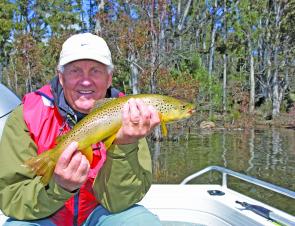
Arthurs Lake is awesome when it is at high levels – this year they are as high as anyone has ever seen them.

The western lakes at waters such as Lake Botsford are best fished in spring before the hordes descend!
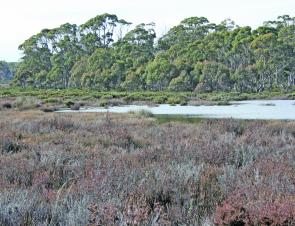
Sunny days shouldn’t be ignored here – some great polaroiding can be had in spring.
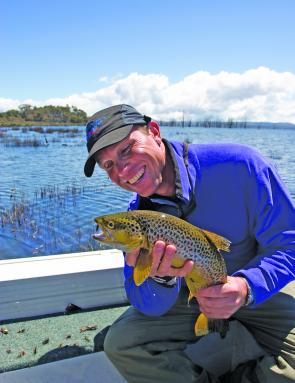
If you can find some grassy bays, then you will undoubtedly find some awesome action. You might need a boat t get to them though.
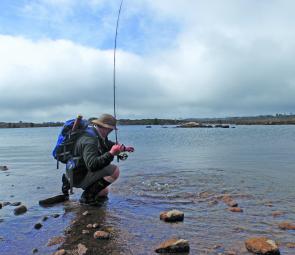
The western lakes might involve a long walk in September, but the rewards are plentiful. Keep an eye on the weather though.
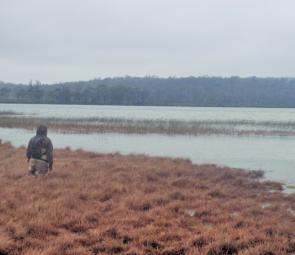
Flooded margins are all the go in September – find the flooded backwaters and listen for the frogs – the trout will have found them first though!
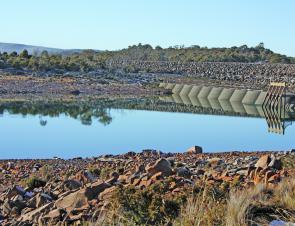
Great Lake can be simply magnificent on calm days – often the fish will be rising too.

Trolling Great Lake on calm days can be an exercise in futility, but looking for midging fish is a different story altogether.

Little Pine Lagoon can provide the best early season fishing on the planet – but it needs to be spilling first.
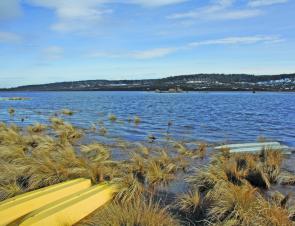
The flooded shores on the Pine – perfect spring conditions.
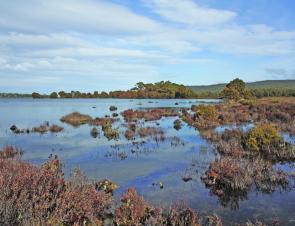
The top end of the Cowpaddock on Arthurs really looks perfect – wait till the frogs start frolicking first though.




